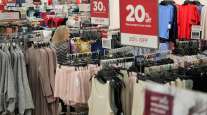Retail Sales Unexpectedly Decline in February

U.S. retail sales unexpectedly eased in February on declines in grocery stores and building materials, which could reflect cooler weather, though also may signal further headwinds for the economy in the first quarter.
The value of overall sales fell 0.2% after an upwardly revised 0.7% increase the prior month, according to Commerce Department figures released April 1. The median forecast of economists surveyed by Bloomberg called for a 0.2% gain.
Sales in the “control group” subset, which some analysts view as a cleaner gauge of underlying consumer demand, also fell 0.2%, missing estimates for a gain, after an upwardly revised 1.7% increase in the prior month. The measure excludes food services, car dealers, building-materials stores and gasoline stations.
The report suggests consumer spending will be limited as a growth driver in the first quarter, with pressure points also including smaller-than-expected tax refunds and global economic weakness that may be weighing on jobs. Even so, rising wages, a stock market rally and steady interest rates are likely to be pillars for consumption in coming months.
“The question that everybody’s got with a lot of this data is: Are we going through a soft patch or is this the start of a more serious retrenchment in consumer spending? And we keep getting mixed signals in that regard,” said Tim Quinlan, a senior economist at Wells Fargo & Co. in Charlotte, N.C.

Seven of 13 major retail categories showed declines, led by a 4.4% drop in building materials and garden supply stores that was the steepest since April 2012. Food and beverage stores posted a 1.2% drop, the most in a decade.
Economists including Capital Economics’ Andrew Hunter said weather likely played an outsize role in February sales. There was record rainfall in parts of the Southeast, major winter storms in the North, including record snowfall and cold temperatures in the Northwest.
The data likely won’t change the expectations of Federal Reserve policymakers for no interest-rate hikes this year amid muted inflation. Officials generally have seen the economy as in good shape, and Fed Vice Chairman for Supervision Randal Quarles said March 29 that the “sharp falloff” in retail sales in December was inconsistent with other indicators. Some economists and analysts have echoed that sentiment.
White House Chief Economic Adviser Larry Kudlow said March 29 that the “underlying economy” isn’t slowing. Still, he called for the Fed to cut interest rates by a half percentage point.
“They were talking about ‘patience’ before as in, no need to rush into another rate hike,” Wells Fargo’s Quinlan said of the Fed. “Now they might have to start using the word ‘patience’ to say there’s no need to rush toward a rate cut.”
Other recent indicators have offered a mixed picture of the U.S. economy. Data on February durable goods orders, due April 2, and the April 5 employment report for March will give a better sense of whether the weakness will be temporary.




